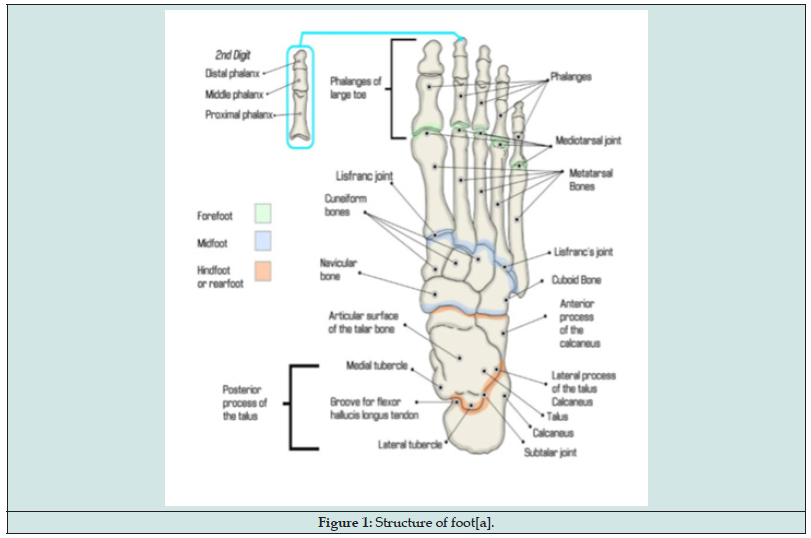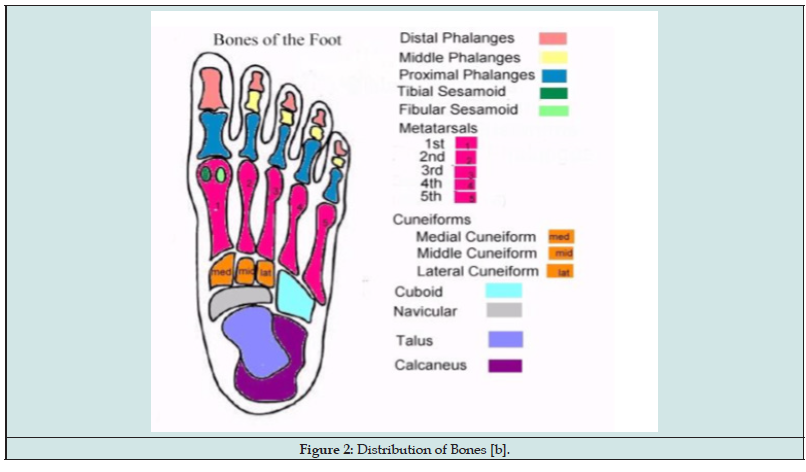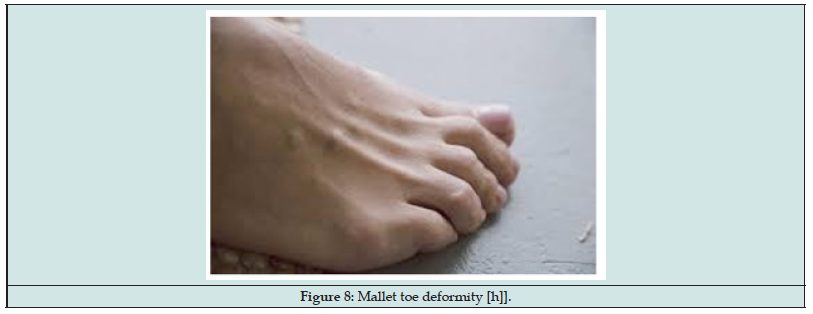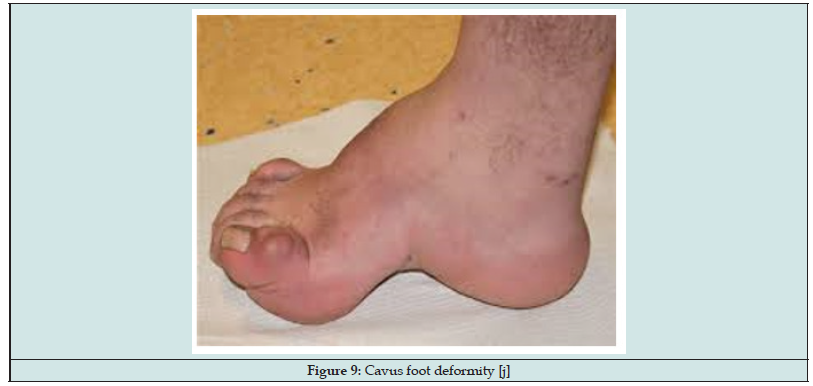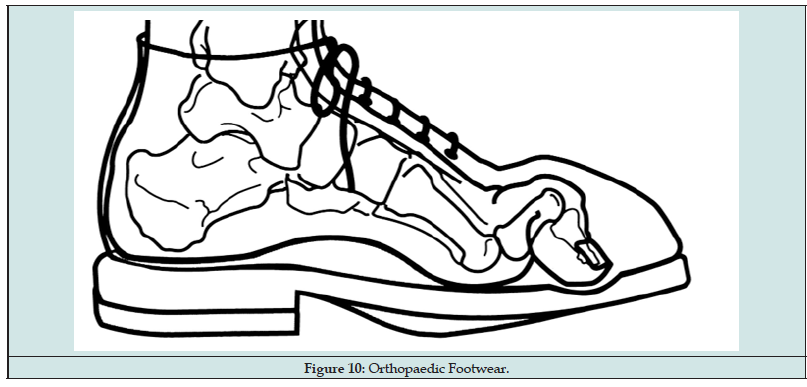
Lupine Publishers Group
Lupine Publishers
Menu
ISSN: 2637-6679
Review Article(ISSN: 2637-6679) 
Orthopaedic Footwear and Foot Deformities: A Review Volume 8 - Issue 3
DK Chaturvedi1* and Arjun Verma2
- 1Head, Department of Footwear Technology, D. E. I. (Deemed to be Univ) Agra, India
- 2Department of Footwear Technology, D. E. I. (Deemed to be Univ), Agra, India
Received: June 16, 2023; Published: June 23, 2023
Corresponding author: D. K Chaturvedi, Head, Department of Footwear Technology, D. E. I. (Deemed to be Univ) Agra, India
DOI: 10.32474/RRHOAJ.2023.08.000286
Abstract
Many people experience problems with their feet and/or ankles. Foot deformities can either present at birth or develop over some time. The definition of foot deformities is not predicted generally. The proposed solutions are surgical or non-surgical methods to cure foot deformities. Custom made shoes are costly which are not affordable to the masses. A comprehensive study of the medical, functional, and technical requirements for this type of footwear is still lacking to date. Hence in this paper, an attempt is made to review different foot deformities and low-cost customized orthopedic shoes for it. The paper is divided into four main parts. The first part deals with the introduction and literature review. The second part is related to the foot anatomy, different deformities, and their causes. The third part deals with the low-cost custom-made shoes for these deformities. Lastly, it discusses the conclusion and future scope.
Keywords: Foot deformities; customized shoes; foot problems; custom shoe last
Introduction
The foot is the bottom most part of the body, which comes in the contact of ground may or may not through footwear. It has two fundamental functions, namely stability of body and dynamics of motion to move forward or backward. The foot has a complex structure to support while standing or moving on even or uneven surfaces [1]. Foot arch indicates that the portion of foot meets the ground and helps in distributing pressure and provides cushioning effect to absorb shocks. Thus, in a healthy foot, the medial longitudinal arch is elevated 15 to 18 mm from the surface, while the lateral arch is elevated 3 to 5 mm [2]. Deformities occur if the above-mentioned ratio of foot arches is disrupted and affects the joints’ performance of the ankle, knee, and hip, which may cause backache. The problem is aggravated due to excessive body weight, weakness of tissue, excessive physical effort, prolonged and improper way of standing and unsuitable footwear [3]. The foot deformities begin with minor foot trauma due to lack of knowledge of foot care [4]. It is fur ther contributed by poverty and illiteracy. Sociocultural practices like walking with barefoot as religious practices, not wearing socks contribute to foot injury and the development of hyperkeratosis, nail problems and heel fissures in the Indian population [5]. The percentage of athletes having foot problems in different parts of the country varies from 25% to 55% and maximum in the athletes of the middle age group. Also, the foot problem to female athletes has more prevalence than men [5]. Foot problems are generally seen in many people independent of age and gender. It may be developed at an early stage or over some time due to various factors like ill-fitting shoe, genetically problem, pointed shoe, lack of education, arthritis etc. Care must be given to feet because approximately 25% of total bones are present in human feet [6]. In general, two methods are likely to be suggested to cure foot deformities i.e., surgical method and non-surgical method. Here low-cost customized method is used for making EVA custom-made orthopaedic shoe for various foot deformities [7-11] (Figures 1 & 2).
Literature review
Ellen Sobel [10] mentioned the weight-bearing foot pressures which were found to be lower when walking with shoes as compared to barefoot. Adding a soft cushioned in the shoe which further decreases the weight-bearing pressure. Asad Ayub [11] said that the initial treatment is primarily conservative and must first address the patient’s footwear. Foot padding, taping, night splints, foot exercises, orthotic devices, nonsteroidal anti-inflammatory medications, or a combination of these treatment modalities may be prescribed. Allowance should be made for adequate space in the shoe to prevent further injury. Orthotic devices may provide short-term symptomatic pain relief for mild to moderate Bunion deformity. J Leng [12], Shuping Xiong [13], and Nibedita Rout [14] proposed different systems for foot scanning to obtain data to fit customer foot shape for custom made shoe last. Then CAD file is prepared according to measurement and prepared the final last using CNC machine and ready for shoe production. Salvatore Moscadini fabricated a soft leather shoe with a wide toe box and preferably a soft sole for relief of symptoms of flat foot and Bunion. Different orthotic devices like bunion pads, night splints, bunion posts etc. may also help in relieving symptoms. No assurance that orthotic devices prevent progression of the deformity, and it is uncomfortable for a patient because it occupies space within the toe box. According to Kilmartin et al (1991) found that the Bunion angle increased more in patients who used orthotics and concluded that orthoses did not prevent progression of a Bunion deformity [15]. A Luximon [16] applied a non-medicated hammertoe pad for hammertoe deformity. Hylton B Menz [17] discussed about all the orthoses were of full length and modified by adding a cut-out section beneath the first metatarsal and trimming the distal edge to level the second to fifth phalanges. Chakma Shimul [18] deals to make custom made shoe last for a deformed person using CAD file and last preparation using CNC machine. On the other hand, J Peixoto [19] used 3D scanning to scan foot and the information utilized by 3D printing machine for making custom made insole. Mike Freckling ton [20] applied an extra-depth in the forefoot region to accommodate forefoot deformity. Soft leather upper and smooth lining offered protection, laces, padded heel counter to improve the fit at the heel side and a long inside counter was given to improve rear foot stability and for supporting arches. Paulus Wisnu Anggoro [21], Nor Rofizah Johari [22], Liliia Chernenko [23,24] prepared a custom-made orthotic insole using CAD file and CNC machine for patients suffering from diabetes. Chul Hyun Park [25] applied treatment for patients who favour footwear with a lower heel and a wider toe box section. An MT bar on the sole of footwear reduces pressure loading on the space between MT heads and transfers it more proximally. Ermakova EO [26] proposed a concept of automated measuring the inner dimensions of a deformed person’s foot and to develop an algorithm using the data. This integrated approach helped to make the custom-made orthopaedic footwear better way. Haddaya Umar [27] conducted a survey on people who were suffering from plantar fasciitis and planned to investigate the impact of daily wear footwear on foot health by mentioning the various features of the shoes worn daily by the sufferer.
Human Foot Anatomy
Foot anatomy is the science of knowing the structure of the feet and interrelation of its parts. The human foot consists of bones, muscles, Ligaments, & Tendons which are covered by the skin. The whole system can support the body while it is standing, walking, and running [28].
Function of Feet
Feet have the following two functions:
a) Supporting the weight of the body to balance in an erect position i.e., stability
b) Propelling the body forward (movement) i.e., flexibility
Introduction of Bones
The skeleton of the body gives strength, supports its weight, and protects the more vulnerable organs. It is formed by long and short bones. Long bones are responsible for its movement and the short bones are associated with the weight bearing of the foot. There are a total of 26 bones present in human foot [17].
Distribution of Bones
It is divided into three parts-
A. Tarsus: Back portion of the skeleton of the human foot is termed as tarsus. It has seven irregular shaped bones. The body weight is transferred through heel bone to the ground.
B. Metatarsus: Consists of five metatarsi (long bones). The first three joins with three cuneiforms and next two with the cuboids.
C. Phalanges: Phalanges are the fourteen long bones forming the toes. It is divided into three subgroups as
a) Tarsus: 7 short bones
b) Metatarsus: 5 – long bones
c) Phalanges: 14 – long bones.
Phalanges is further classified as: +
a. Proximal phalanges (5- bones)
b. Middle phalanges (4-bones)
c. Distal phalanges (5-bones)
Foot Deformities
Deformities can be painful and affect the way you walk. It may cause hard and thick skin, and lead to calluses and pressure sores. Sometimes misalignments (wrong bone positions) can cause toes and other parts of the foot to become deformed too. This applies abnormal strain on tendons and muscles, which may even tear as a result [29]. Abnormal strain on joints can lead to wear-and-tear, and eventually to osteoarthritis. Further risk factors include injuries, inflammations and being overweight, as well as diseases such as osteoarthritis, rheumatoid arthritis, or brain diseases. Genes usually play an important role. For instance, some people have weak con nective tissue, so the supporting structures in the foot can’t always hold everything in place properly [30].
Various foot Deformities
Hammer toe
hammer toe is a kind of deformity in which the human toe tends to bend or curl downwards instead of pointing forward as shown in Figure 3. It generally affects the second, third, and fourth toe. Although, it may be present at birth and develop over some time due to arthritis or wearing some ill-fitting shoes, such as tight, pointed heels. In most cases, a hammer toe condition is treatable [31].
Bunion
A bunion also called hallux valgusis a type of foot deformity occurs at first metatarsal phalangeal joint as shown in Figure 4. In this, the big toe generally bends towards the other toes and the joint also becomes red and sometimes painful. The exact cause is still unclear. Some proposed factors include wearing overly tight shoes, high-heeled shoes, family history, and rheumatoid arthritis [32-34].
Splayfoot
In splayfoot deformity, the metatarsal bones are spread out as shown in Figure 5 and the front end of the foot becomes wider. As a result, more pressure is put on the middle bones in the forefoot. It is generally painful, and can make the skin hard and thick, leading to calluses. People with splayfeet are also more likely to develop hallux valgus. In this, the first metatarsal bone moves sideways (towards the other foot) and the big toe moving towards the neighbouring toes [16,29].
Fallen arch/ Flat foot.
Flat foot is a common deformity in which the medial longitudinal arch is reduced or eliminated as shown in Figure 6, when standing and walking, the foot touches the floor. Fallen arches become painful after several years, mainly when you put more weight on them. Some extreme cases of fallen arches or flat foot are referred to as flat feet. The possible causes of fallen arches include weak foot muscles, abnormal strain on the foot, unsuitable footwear, and some joint inflammations [16,29].
Claw toe
It affects the four smaller toes at a same time. It is bend at the joint as shown in Figure 7. where the foot and the toes meet. It is bend down at the middle joints and at the joints which is nearest to the tip of the toes. As a result, it causes the toes to curl down towards the floor [16,29,31].
Mallet toe
This toe is bent down at the joint as shown in Figure 8. which is closest to the tip of the toe. It affects the second toe, but there is a chance of occurring in the other toes too [16,29].
Cavus Foot
It is a condition in which the child has an excessively high arch as shown in Figure 9. Most of the time, the heel of the foot is turned inwards (called Cavo varus foot deformity). The condition frequently affects both the feet and often progressive [16,29-30].
Orthopaedic Shoes
Many people experience problems with their feet and/or ankles. Orthopaedic footwear can help in preventing or reducing these problems. For a successful outcome, it is essential that customized orthopaedic shoes are used. We investigated the relationship between a person’s decision to use the shoes and aspects of the usability, such as effectiveness, comfort, and cosmetics. It is found that all aspects of usability are important. Therefore, clinicians and shoe technicians should focus not only on the effect alone but also on the comfort and cosmetics of the shoes to make the best pair of shoes for the people who have deformed foot [32]. The main problem of custom-made shoes is the high cost. The major cost of custom- made shoes lies in its custom made last. The cost of these last can be reduced if they are made in one stroke and with reusable material (Figure 10).
Mallet toe
Conclusion
The paper deals with the review of different foot deformities and its orthopaedic shoes. Most of the researchers tried to increase the distal limit area of toe box for the person who were suffering from different types of foot deformities. As a result, the shape of footwear affects the aesthetics appeal. Custom made shoes are very costly and its cost depends upon the type of foot deformity. Individual shoe last is required for a deformed foot, which cannot be reused. Preparation time for making custom made footwear according to the type of deformity is more. The custom-made footwear is heavy. Hence, there is a need to Design and Develop customized orthopaedic shoes which are cheap, light in weight, washable, good looking and cater with different foot deformities.
Acknowledgment
The authors are extremely thankful to Prof. P.S. Satsangi, Chairman, Advisory Committee of Education, Dayal Bagh, Agra for his guiding and inspiring us in our research work. We express our gratitude towards Prof. P.K. Kalra, Director, D.E.I. and the Lab Staff Mr. Aman Kushwah, Anoop Saran for their kind support and help provided during experimentations.
References
- Oatis CA (2009) Kinesiology - The Mechanics and Pathomechanics of Human Movement. Baltimore Lippincott Williams Wilkins: Wolters Kluwer Business.
- Kapandji IA (2011) The Physiology of Joints. The Lower Limb. 6th edn. Vol 2. Edinburgh, London, New York, Oxford, Philadelphia, St. Louis, Sydney, Churchill Livingstone, Toronto, USA.
- Mosca VS (2010) Flexible flatfoot in children and adolescents. J Child Orthop 4(2): 107-121.
- Shankhdhar K, Shankhdhar LK, Shankhdhar U, Shankhdhar S (2008) Diabetic foot problems in India: an overview and potential simple approaches in a developing country. Current diabetes reports 8(6): 452-457.
- HB Chandalia, D Singh, V Kapoor, S H Chandalia, PS Lamba (2008) Footwear and foot care knowledge as risk factors for foot problems in Indian diabetics, Int J Diabetes Dev Ctries 28(4): 109-113.
- Balasankar Ganesan, Palak Prasad, Suraiya Akter, Raymond KY Tong (2021) Handbook of Footwear design and Manufacture (Second Edition), The Textile Institute Book Series pp. 413-438.
- WILKINSON CR (1948) Last Development and Design Ibid. 3: 472
- Omprakash H Nautiyal (2012) Molding of EVA Soles Using Expanding and Reducing Agents. International Journal of Engineering Science and Technology 4: 7.
- Ahmad Adlie Shamsuri (2015) Compression Moulding Technique for Manufacturing Biocomposite Products, International Journal of Applied Science and Technology 5: 3.
- Ellen sobel, Steven J Levitz (2001) Pressure reduction and off-loading the diabetic foot, Journal of Continuing Medical Education by the Council on Podiatric Medical Education.
- Asad Ayub, Steven H Yale, Christopher Bibbo (2005) Common Foot Disorders, Journal in Clinical Medicine, and Research 3(2): 116-119.
- J Leng, R Du (2005) A Deformation Method for Shoe Last Customization, Computer-Aided Design Applications 2: 11-18.
- Shuping Xiong, Jianhui Zhao, Zuhua Jiang, Ming Dong (2009) A computer-aided design system for foot-feature-based shoe last customization. Int J Adv Manuf Technol 46: 11-19.
- Nibedita Rout, Asim ananda Khandual, Yi Fan Zhang, Ameer sing Luximon (2010) 3D Foot Scan to Custom Shoe Last, International Journal of Computer and Communication Technology.
- Salvatore Moscadiniand Giuseppe Moscadini (2012) Hallux Valgus correction in young patients with minimally invasive technique, the role of Osteotomy in the correction of Congenital and acquired disorders of the skeleton.
- A Luximon (2013) Handbook of footwear design and manufacture, Woodhead Publishing Limited. Cambridge, USA.
- Hylton B Menz, Maria Auhl, Jade M Tan, Pazit Levinger, Edward Roddy, et al. (2016) Biomechanical Effects of Prefabricated Foot Orthoses and Rocker-Sole Footwear in Individuals with First Metatarsophalangeal Joint Osteoarthritis. Arthritis Care Research 68(5): 603-611.
- Chakma Shimul, Kanish Fatama, Nur E Alam, Akhtar Hossain (2018) Development of shoe last with convex shape for placing orthotics in footwear. International Journal of Advanced Research in Science, Engineering and Technology pp. 7208-7212
- J Peixoto, P Flores, A P Souto (2017) A new approach to implement a customized anatomic insole in orthopaedic footwear of lower limb orthosis. Materials science and Engineering 254(23): 232006.
- Mike Frecklington, Nicola Dalbeth, Peter McNair, Peter Gow, Anita Williams, et al. (2018) Footwear interventions for foot pain, function, impairment, and disability for people with foot and ankle arthritis: A literature review. Seminars in Arthritis and Rheumatism 47(6): 814-824.
- Paulus Wisnu Anggoro, M Tauviqirrahman, J Jamari, AP Bayuseno, B Bawono, et al. (2018) Computer-aided reverse engineering system in the design and production of orthotic insole shoes for patients with diabetes. Cogent Engineering 5: 1.
- Nor Rofizah Johari, Khatijah Md Saad (2019) Design Investigation on foot deformities working footwear. Journal of Information System and technology management 4(15): 41-47.
- Liliia Chertenko, Tatjana Spahiu, Bogdan Sarghie, Armand A Golli (2021) Mordern shoe last design and challenges Encountered. Proceedings pp. 66-72.
- Liliia Chertenko, Brian G. Booth (2022) Modelling shape and parameterizing style: an approach to the design of high-fashion shoe lasts. Footwear Science pp. 199-218.
- Chul Hyun Park, Min Cheol Chang (2019) Forefoot disorders and conservative treatment. Yeungnam Univ J Med 36(2): 92-98.
- Ermakova EO, Kiselev SU, Kostyleva VV (2020) A Concept of Automated Selection of Orthopedic Shoes. Advances in Health Sciences Research Atlantis Press ICHW 28: 119-124.
- Haddaya Umar, Wajeeha Idrees, Wardah Umar, Anish Khalil, Zuhair A Rizvi (2022) Impact of routine footwear on foot health: A study on plantar fasciitis. Journal of Family Medicine and Primary Care 11(7): 3851-3855.
- Somenath Ganguly (2022) Comprehensive footwear technology, Journal of Indian Leather Technologists Association, India.
- Ferri Fred F (2010) Ferri's Differential Diagnosis E-Book: A Practical Guide to the Differential Diagnosis of Symptoms, Signs, and Clinical Disorders, Elsevier Health Sciences 323.
- Roddy E, Muller S, Rome K, Chandratre P, Hider SL, Richardson J, et al. (2015) Foot problems in people with gout in primary care: ba seline findings from a prospective cohort study. J Foot Ankle Res 8: 31.
- Chadwick C, Saxby TS (2011) Hammertoes/Claw toes: metatarsophalangeal joint correction. Foot and Ankle Clinics 16 (4): 559-571.
- ImrulKayes Limon, Md. Rafiul Hasan, Dewan Mahbub Hasan, Muhammad Naimul Hasan, and Md. SamsulArefin (2019), fabrication of customized shoe last for deformed foot using plaster of paris: an approach to enhance foot comfort, International Conference on Mechanical Engineering and Renewable Energy.

Top Editors
-

Mark E Smith
Bio chemistry
University of Texas Medical Branch, USA -

Lawrence A Presley
Department of Criminal Justice
Liberty University, USA -

Thomas W Miller
Department of Psychiatry
University of Kentucky, USA -

Gjumrakch Aliev
Department of Medicine
Gally International Biomedical Research & Consulting LLC, USA -

Christopher Bryant
Department of Urbanisation and Agricultural
Montreal university, USA -

Robert William Frare
Oral & Maxillofacial Pathology
New York University, USA -

Rudolph Modesto Navari
Gastroenterology and Hepatology
University of Alabama, UK -

Andrew Hague
Department of Medicine
Universities of Bradford, UK -

George Gregory Buttigieg
Maltese College of Obstetrics and Gynaecology, Europe -

Chen-Hsiung Yeh
Oncology
Circulogene Theranostics, England -
.png)
Emilio Bucio-Carrillo
Radiation Chemistry
National University of Mexico, USA -
.jpg)
Casey J Grenier
Analytical Chemistry
Wentworth Institute of Technology, USA -
Hany Atalah
Minimally Invasive Surgery
Mercer University school of Medicine, USA -

Abu-Hussein Muhamad
Pediatric Dentistry
University of Athens , Greece

The annual scholar awards from Lupine Publishers honor a selected number Read More...

.png)


